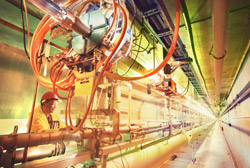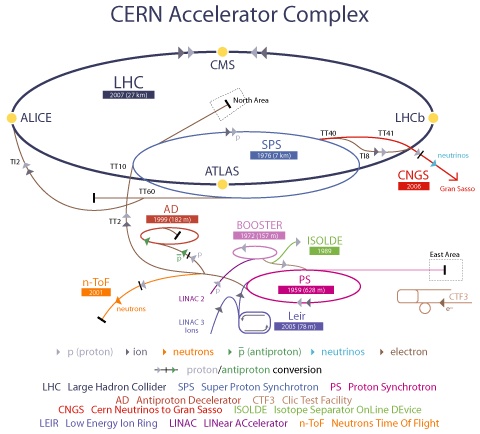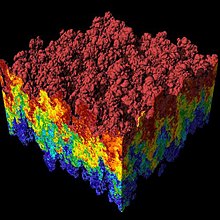Keck Computational Science Center
Physics
CERN
University faculty and students are involved in an exciting ATLAS research program
at the Large Hadron Collider (LHC) of the European Organization for Nuclear Research (CERN) near Geneva, Switzerland. There are -10,000 scientists from -600  institutions of -100 countries currently doing their research at CERN. The 10 billion
dollar LHC started collision in November 2009 and will remain as the world's most
powerful collider until at least 2030 with great discovery potential. LHC has been
one of the most ambitious and exciting scientific projects in human history. The ATLAS
(A Ioroidal1HC ApparatuS) is a flagship LHC experiment designed to search for new
physics.
institutions of -100 countries currently doing their research at CERN. The 10 billion
dollar LHC started collision in November 2009 and will remain as the world's most
powerful collider until at least 2030 with great discovery potential. LHC has been
one of the most ambitious and exciting scientific projects in human history. The ATLAS
(A Ioroidal1HC ApparatuS) is a flagship LHC experiment designed to search for new
physics.
The ATLAS collaboration consists of -3000 physicists from -180 institutions of 37 countries all over the world. Among them there are -500 physicists from -40 prestigious U.S. universities (e.g. Harvard, Yale, MIT, Columbia, University of Chicago, UC-Berkeley, University of Michigan, University of Washington, etc.) and national labs (Argonne National Lab, Brookhaven National Lab, Lawrence Berkeley National Lab, and Stanford Linear Accelerator Center). Fresno State is the only CSU campus on ATLAS.
This provides our students outstanding research opportunities, unique in the CSU system, at CERN for the next 20 years or longer. To provide the ATLASILHC research opportunity to a wider CSU community, we are building a CSU ATLAS Consortium. Nine other campuses (Dominguez Hills, Humboldt, Long Beach, Los Angeles, Pomona, Sacramento, San Bernardino, San Francisco, and Stanislaus) have joined the consortium.
Since 2008, 13 CSU students (nine from Fresno, four from Long Beach and Sacramento), of which 11 are undergraduates, have worked on ATLAS research projects at CERN. In March 2010, NSF awarded Prof. Yongsheng Gao a two-year $620,000 Major Research Instrumentation (MRI) grant to set up ATLAS Grid Computing Tier 3 facilities at all the nine NSF funded institutions on ATLAS. We are setting up the facility at Fresno State to search for new physics with ATLAS data.
The CSC is providing work space for students of the Fresno State ATLAS group and CSU
ATLAS Consortium to work on ATLAS physics using the Fresno State Tier 3 facility to
access the ATLAS data. The CSC is used for tutorials and training with ATLAS software
and tools to analyze ATLAS data for CSU ATLAS Consortium students. The CSC allows
our students to actively work on ATLAS physics without traveling to CERN. It serves
as a bridge for our students to the world center of high-energy physics.
Biomedical Physics
A second instruction and research area is biomedical physics. Development of medical
imaging equipment, as with much modem technology, is best achieved with the aid of
extensive computer simulation. For projection X-ray, X-ray CT, and nuclear medicine
imaging, Monte Carlo simulation is especially useful in determining the transport
of photons from their source, through the patient, and through  collimation and detection apparatus to give a pattern of energy depositions in the
detector that is the basis for the eventual image. Although photon scattering and
absorption are conceptually straightforward, the equations become intractable for
multiple generations scattering distributions that change as a scattered photon loses
energy. Monte Carlo modeling, however, is a straightforward, well-tested, and highly
successful technique for understanding photon transport.
collimation and detection apparatus to give a pattern of energy depositions in the
detector that is the basis for the eventual image. Although photon scattering and
absorption are conceptually straightforward, the equations become intractable for
multiple generations scattering distributions that change as a scattered photon loses
energy. Monte Carlo modeling, however, is a straightforward, well-tested, and highly
successful technique for understanding photon transport.
Dr. Charles Tenney is investigating equipment designs for breast cancer detection through radiotracer imaging. Such systems are attracting interest for cases in which tumors are difficult to detect using X-ray mannnography. Although a workstation adequate for this type of simulation is available, there are cases in which greater simulation capability translates directly to better knowledge-the more situations can be effectively modeled, the more designs can be examined, and the more readily a design can be optimized.
In addition, the computational power offered by the Computational Science Center will make it practical to consider using Monte Carlo models, as well as complex tomographic reconstruction software, in teaching X-ray physics and nuclear medicine physics classes in the Biomedical Physcis curriculum (PHYS 156 and PHYS 157 respectively).